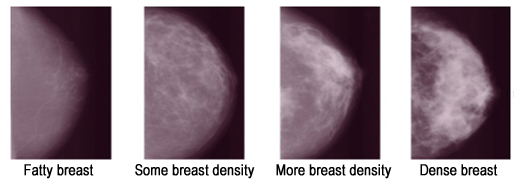
Breast density is a measure of how much connective tissue there is compared to fat. The more connective tissue, the denser the breast. However, density is not based on how breasts feel, it’s based on how they look on a mammogram.
Higher density breasts are actually quite common — upwards of half of the women in the U.S. ages 40-74 have them. Young, thin women as well as women of a healthy weight are more apt to have dense breasts than obese women. Also, as women age, their breasts tend to become more fatty and less dense. However, taking postmenopausal hormones (MHT) can slow this process and increase density.
Since mammograms are the only way to measure breast density, scheduling mammograms at the recommended times are key — women with dense breast tissue are 4-5 times more likely to develop breast cancer. For women who have dense breast tissue, there are additional screenings, such as the ultrasound breast imaging system (whole breast ultrasound), that help to locate cancers that may be hidden in dense tissue.
There are four classifications of breast density based on how the tissue looks on a mammogram:

*Image from Susan G. Komen website
Depending on the density and other possible risk factors, women and their health care providers can determine the best types of screening.
The Difference Between Density Classifications and BI-RAD
Breast density classifications based on mammogram findings are not the same as what are called BI-RADs score — or the Breast Imaging Reporting and Data System — which is another system that puts the results into categories based on abnormalities found or not found. The BI-RADs scores range from zero to six, zero indicating additional imaging may be needed because the image was unclear, one indicating it was negative and there were no abnormalities — all the way up to six which is a category in which findings in a mammogram have already been shown to be cancer by previous biopsy.

